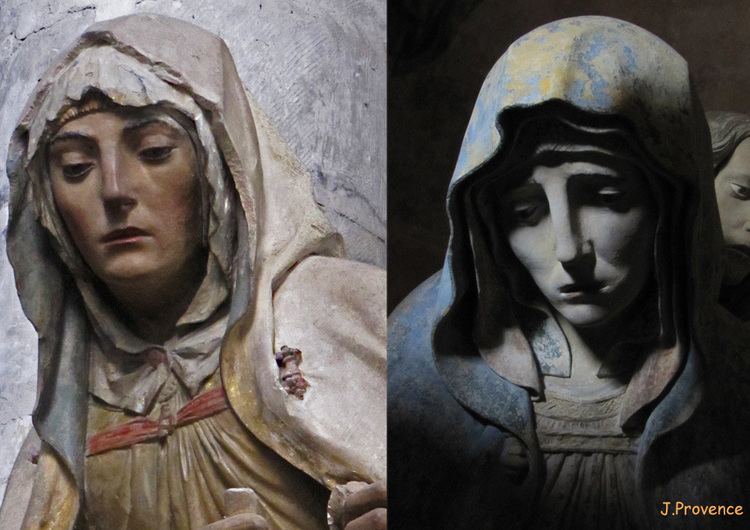 | ||
The Maître de Chaource was an unidentified sculptor who worked in the late 15th and early 16th century, in the French town of Chaource. While many works are attributed anonymously to him or his atelier, some scholars have identified Jacques Bachot as the artist. There is certainly circumstantial evidence which points to Bachot; he was a contemporary of the Maître de Chaource and often worked in the same locations and works by Bachot such as that in the church of Saint-Laurent in Joinville, of which fragments are held in the Joinville Town Hall, show great similarities to the work of the Maître de Chaource.
Contents
- Other works possibly by the Matre de Chaource his atelier or the cole de Troyes
- Christ on the Cross at Fueges
- Other reading
- References
In 1992, Heinz-Herman Arnhold wrote that the works of the Maître de Chaource's atelier can be seen from Reims in the north to Ravières in the south and from Langres in the east to Villeneuve-l'Archevêque in the west.
Arnhold's thesis covers that sculpture of Troyes and southern Champagne created between 1480 and 1540 by regional masters, and he states that no other region in France in the time from the late 15th century to the middle of the 16th century has had a richer production of sculptures. Sculpture in southern Champagne flourished at a time when the arts in the neighbouring regions of Lorraine, Burgundy and the Île-de-France had already passed their peak and Arnhold concludes that the reasons for this can be found in the economic prosperity of Troyes, the old capital city of the counts of Champagne. This prosperity was based partly on Troyes' geographic position, being a transit point both of the trade routes between Northern France and the Netherlands and Southern France and Italy and also on the making and selling of fine cloth throughout Europe. It was the church and the monasteries, the nobility, corporations and rich merchant families who undertook most of the commissions, competing by their orders for the religious and artistic improvement of the churches and noble town-palaces, mostly situated in and near Troyes.
Arnhold writes that the region's sculptors and their workshops, as was the case with painters, created, developed and maintained a regional and iconographical style which persisted until around 1540 and concentrated very much on themes linked to the Passion of Christ such as the "Pietà" or "Vierge de pitié" and "Christ de Pitié". The sculptures of 'Ecce Homo', the Entombment of Christ, the Descent from the Cross, but also the Virgin and Child, the Education of Mary as well as different Saints which were venerated in Champagne, are the most important and numerously represented subjects. The mood of the Passion is expressed in studies of suffering and sorrow all portrayed with an inordinate feeling of resignation.
The Master of Chaource, so named because of his magisterial "Entombment" in Chaource of 1515, is the region's most important sculptor with a characteristic style which Arnhold explores in the first part of this work. He also catalogues 329 works with nearly 400 illustrations thus providing an invaluable resource for those studying the region's 16th century sculpture and he not only makes attributions where possible to the Maître de Chaource but also explores the extent to which the Maître's style influenced other workshops in the region, such the workshop of Saint-Léger, that of the Master of Rigny-le-Ferron and the workshop of Vendeuvre-sur-Barse.
Arnhold discusses the work of Nicolas Halins for the western facade of Troyes cathedral, and hypothesizes about whether Halins could have been the Maître de Chaource.
Arnhold also links the two statues of Saint John in the "Chapelle des Annonciades" in Langres with the Maître de Chaource.
Other works possibly by the Maître de Chaource, his atelier or the École de Troyes
Whilst most scholars attribute the above six works to the Maître de Chaource, there are other works of the 16th century and in the Troyes region that some attribute to the Maître de Chaource and others do not. Of course the anonymity of the title "Maître de Chaource" does not help so it may be better to put these under the name "The École de Troyes" or the "École du Maître de Chaource"
Christ on the Cross at Fueges
Arnhold attributes this work to the Maître de Chaource for stylistic reasons and sees similarities with the work in Mailly-le-Camp. He dates the work to 1520. He also writes that carvings of Christ on the Cross in the Musée des Beaux Arts in Troyes could be by the Maître de Chaource as well as works in churches in Avant-lès-Ramerupt and in Mussy-sur-Seine.
